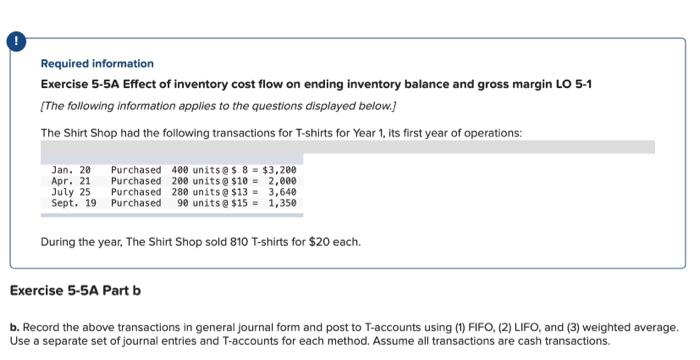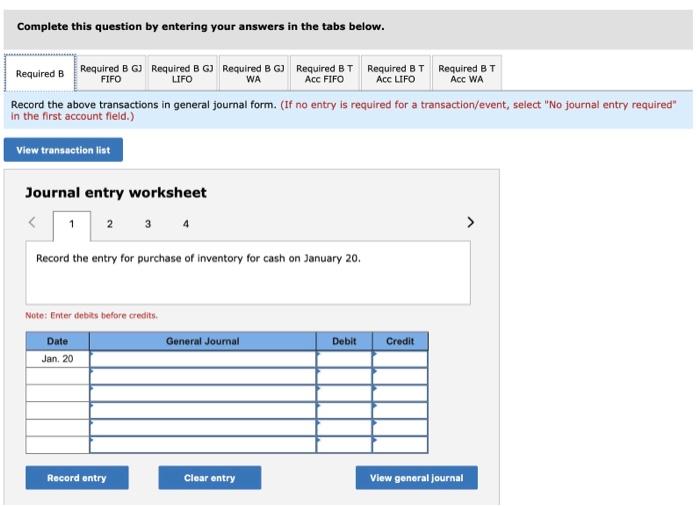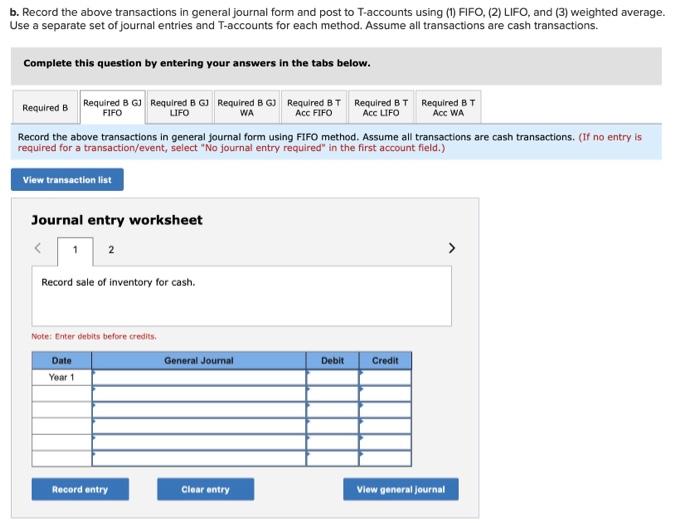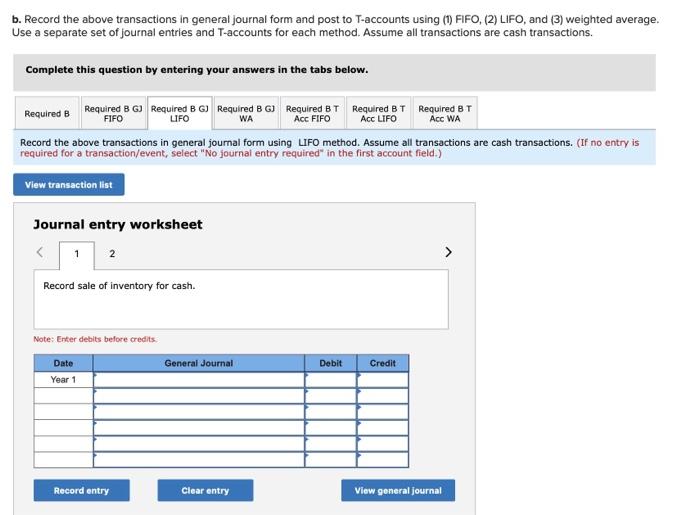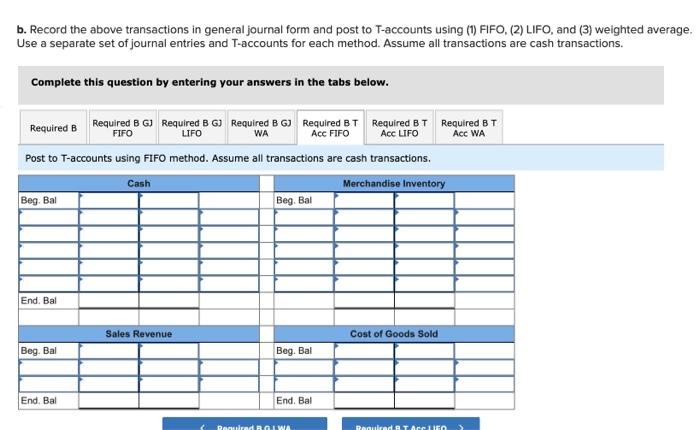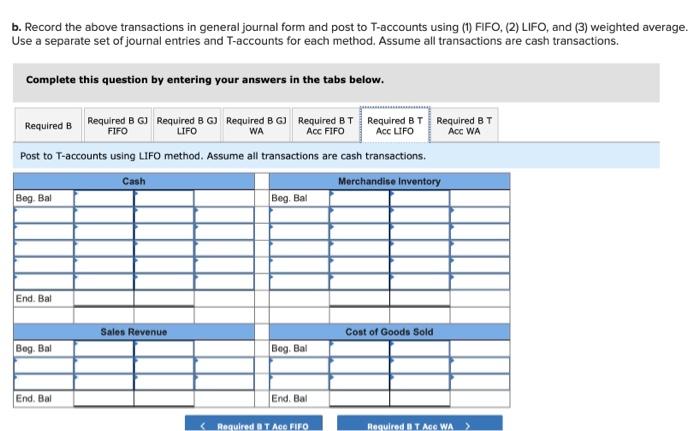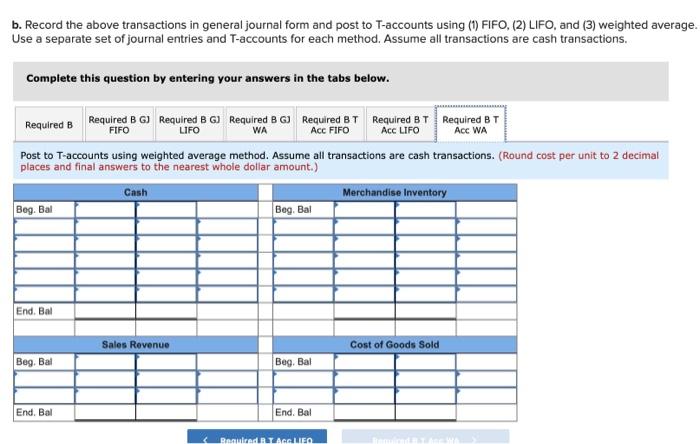Required information Exercise 5-5A Effect of inventory cost flow on ending inventory balance and gross margin LO 5-1 (The following information applies to the questions displayed below.) The Shirt Shop had the following transactions for T-shirts for Year 1. its first year of operations: Jan. 28 Purchased 400 units @ $ 8 = $3,200 Apr. 21 Purchased 200 units @ $10 = 2,000 July 25 Purchased 280 units @ $13 = 3,640 Sept. 19 Purchased 90 units @ $15 = 1,350 During the year, The Shirt Shop sold 810 T-shirts for $20 each. Exercise 5-5A Part 6 b. Record the above transactions in general Journal form and post to T-accounts using (1) FIFO. (2) LIFO, and (3) weighted average. Use a separate set of journal entries and T-accounts for each method. Assume all transactions are cash transactions Complete this question by entering your answers in the tabs below. Required B Required BG Required BG Required B G Required BT Required BT Required BT FIFO LIFO WA Acc FIFO Acc LIFO Acc WA Record the above transactions in general journal form. (If no entry is required for a transaction/event, select "No journal entry required" In the first account field.) View transaction list Journal entry worksheet 1 2 3 4 > Record the entry for purchase of inventory for cash on January 20. Note: Enter debits before credits. General Journal Debit Credit Date Jan. 20 Record entry Clear entry View general Journal b. Record the above transactions in general journal form and post to T-accounts using (1) FIFO, (2) LIFO, and (3) weighted average. Use a separate set of journal entries and T-accounts for each method. Assume all transactions are cash transactions. Complete this question by entering your answers in the tabs below. Required B Required B G Required B G Required 8 GJ Required BT Required BT Required BT FIFO LIFO WA Acc FIFO Acc LIFO Acc WA Record the above transactions in general journal form using FIFO method. Assume all transactions are cash transactions. (If no entry is required for a transaction/event, select "No journal entry required" in the first account field.) View transaction list Journal entry worksheet 1 2 > Record sale of inventory for cash. Note: Enter debits before credits. Date General Journal Debit Credit Year 1 Record entry Clear entry View general Journal b. Record the above transactions in general journal form and post to T-accounts using (1) FIFO, (2) LIFO, and (3) weighted average. Use a separate set of journal entries and T-accounts for each method. Assume all transactions are cash transactions. Complete this question by entering your answers in the tabs below. Required B Required BG Required BG Required BG Required BT Required BT Required BT FIFO LIFO WA Acc FIFO Acc LIFO Acc WA Record the above transactions in general journal form using LIFO method. Assume all transactions are cash transactions. (If no entry is required for a transaction/event, select "No journal entry required in the first account field.) View transaction list Journal entry worksheet Record sale of inventory for cash. Note: Enter debits before credits Date General Journal Debit Credit Year 1 Record entry Clear entry View general journal b. Record the above transactions in general journal form and post to T-accounts using (1) FIFO. (2) LIFO, and (3) weighted average. Use a separate set of journal entries and T-accounts for each method. Assume all transactions are cash transactions Complete this question by entering your answers in the tabs below. Required B Required 8 GJ Required BG Required BG Required BT Required BT Required BT FIFO LIFO WA Acc FIFO Acc LIFO Acc WA Record the above transactions in general journal form using weighted average method. Assume all transactions are cash transactions. (If no entry is required for a transaction/event, select "No journal entry required" in the first account field. Round cost per unit to 2 decimal places and final answers to the nearest whole dollar amount.) View transaction list Journal entry worksheet
